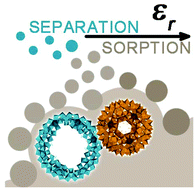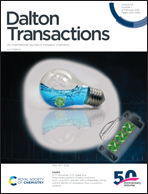The cooperative effect of the sorption of volatile molecules into metal–oxide frameworks as a function of the dielectric constant†
Abstract
The separation of volatile molecules into metal–oxide frameworks (MOxF) is possible with the combination of two approaches: spatial confinement and sorption–desorption equilibria. We have shown that nanoporous MOxF, namely giant POMs with Keplerate or toroidal structures, have a specific sorption behaviour towards different volatile substances that can be generalized through the dependence of the limit sorption on the dielectric constant and molecular polarizability. Assisted by the Hildebrand and Hansen solubility parameters and the Snyder polarity index, an analysis of sorption behaviour shows that the contributions of hydrogen bonding, hydrophobic forces and polar and dispersion interactions can be expressed through a cooperative phenomenon (the formation of a quasi-liquid layer) correlated with dielectric constant as a major parameter. The obtained data can be used to predict the separation of volatile substances using MOxF-embedded hybrid materials, such as selective membranes.



 Please wait while we load your content...
Please wait while we load your content...